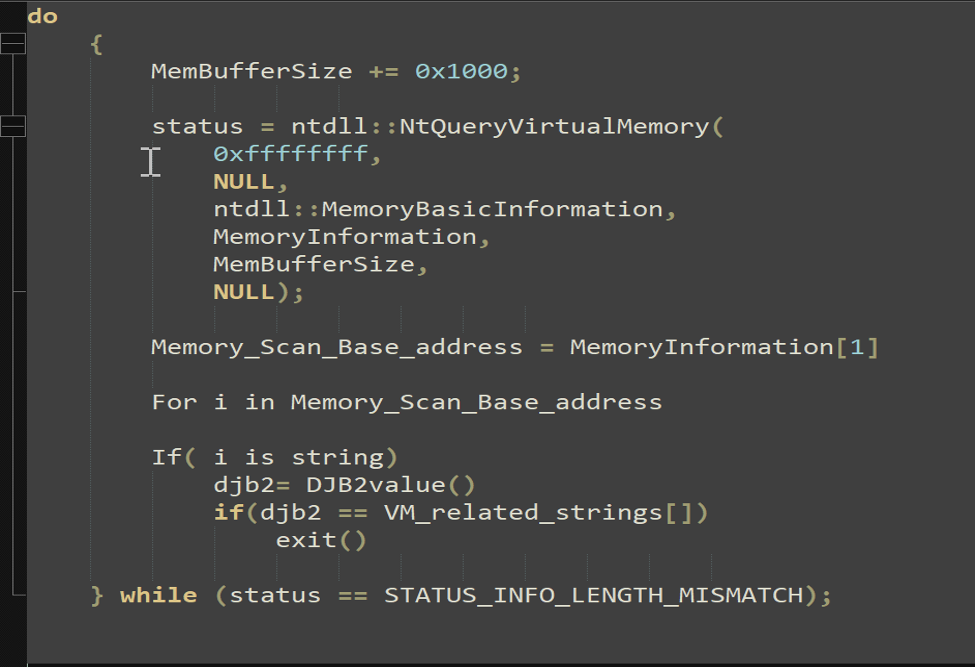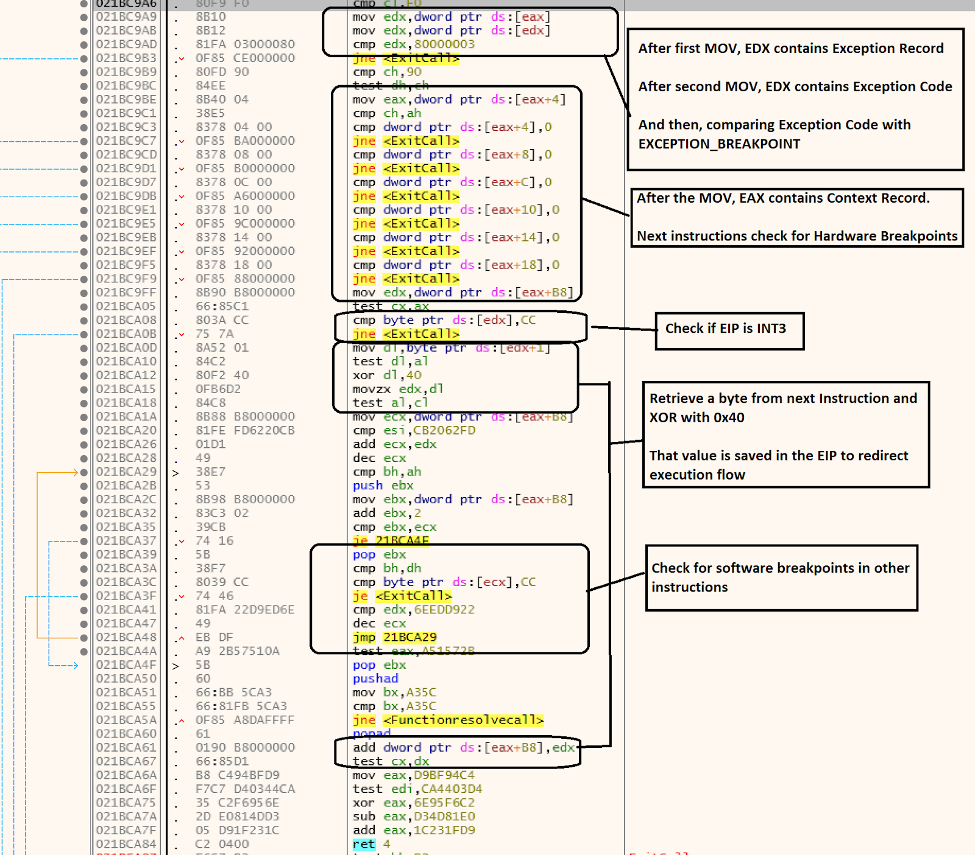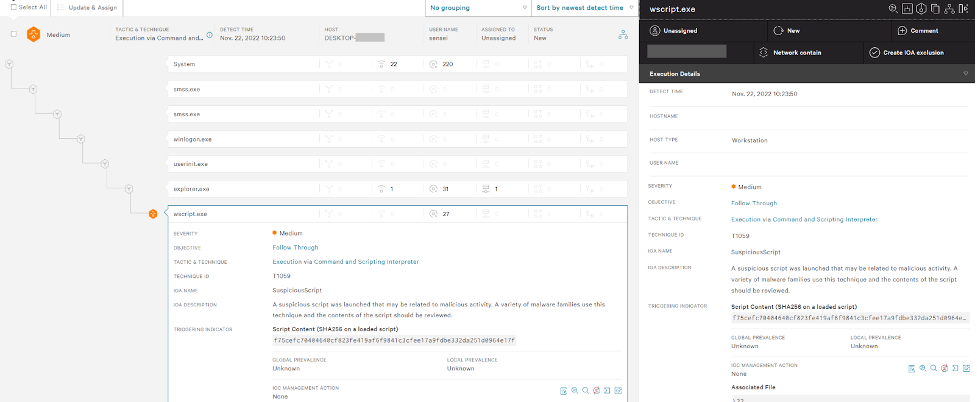- GuLoader is an advanced malware downloader that uses a polymorphic shellcode loader to dodge traditional security solutions
- CrowdStrike researchers expose complete GuLoader behavior by mapping all embedded DJB2 hash values for every API used by the malware
- New shellcode anti-analysis technique attempts to thwart researchers and hostile environments by scanning entire process memory for any virtual machine (VM)-related strings
- New redundant code injection mechanism means to ensure code execution by using inline assembly to bypass user mode hooks from security solutions
CrowdStrike analyzes malware to augment the behavior and machine learning-based detection and protection capabilities built into the CrowdStrike Falcon® platform to deliver automated, world-class protection to customers.
GuLoader has been known to employ a significant number of anti-analysis techniques, making detection and protection challenging for other security solutions.
In dissecting GuLoader’s shellcode, CrowdStrike revealed a new anti-analysis technique meant to detect if the malware is running in a hostile environment by scanning the entire process memory for any Virtual Machine (VM)-related strings. To bypass GuLoader’s anti-debugging evasion mechanisms, we found and described two new working methods for patching debugger instructions meant to detect the presence of debugging tools used by researchers for analysis.
This analysis includes what we believe is the first-ever mapping of all remaining DJB2 hash values for every API used by the GuLoader malware, revealing the first-ever complete view into the malware’s behavior and how it interacts with the victim's machine.
See for yourself how the industry-leading CrowdStrike Falcon platform protects against modern threats like GuLoader. Start your 15-day free trial today.
The Evolution of GuLoader
GuLoader was first spotted in 2019 as a file downloader that was used to distribute remote access trojans (RATs) such as AgentTesla, FormBook, Nanocore, NETWIRE and the Parallax RAT.
These early versions of GuLoader were distributed via spam email campaigns containing archived attachments containing the malware in executable form. In 2020, CrowdStrike published a detailed analysis of GuLoader in which a significant number of DJB2 hash values were mapped, revealing some of the APIs abused by the malware.
Recent variants started using an updated delivery mechanism where the payload is delivered via a Visual Basic Script (VBS) file. GuLoader also started employing advanced anti-analysis techniques to evade detection, such as anti-debug, anti-sandbox, anti-VM and anti-detection to make analysis difficult.
By analyzing the new GuLoader samples, we’re able to reveal and understand every anti-analysis and evasion technique being employed and paint a complete picture of the malware’s behavior.
GuLoader’s Multistage Deployment
The recent GuLoader sample exhibits a multistage deployment:
- The first stage involves using a VBS dropper file to drop a second-stage packed payload into a registry key. It then uses a PowerShell script to execute and unpack the second stage payload from the registry key within memory.
- The second stage payload performs all anti-analysis routines (described below), creates a Windows process (e.g., an ieinstal.exe) and injects the same shellcode into the new process.
- The third stage reimplements all the anti-analysis techniques, downloads the final payload from a remote server and executes it on the victim’s machine.
Existing public research on GuLoader’s multistage deployment has extensively covered a wide range of anti-evasion techniques and behaviors. We used this as a starting point to further our analysis.
VBScript
The VBScript contains two main arrays. One of them is the shellcode present in hex format that will be injected into memory and the second is a Base64-encrypted PowerShell script. For persistence, this shellcode is then added to the Registry Key (HKEY_CURRENT_USER\SOFTWARE\TYMPANIESI) by the VBScript. Another variable “MEDITABU” with Base64 content is being merged and after decoding it forms a PowerShell script.
PowerShell Script
The PowerShell script adds a Microsoft .NET class to a PowerShell session using Add-Type -typedefinition. It then reads the shellcode from the registry entry created by the VBScript and loads the shellcode into the virtually allocated memory space using the API ZwAllocateVirtualMemory and RtlMoveMemory. After that, the shellcode is launched inside powershell.exe using the API Callwindowprocw function.
The first 40 bytes of the shellcode are executable assembly instructions and the remaining bytes are encrypted. The first 40 bytes are responsible for decrypting the remaining part of the code, then the execution flow jumps into the decrypted part. During the next stage, the shellcode replaces the first 40 hex bytes with a no operation (NOP) instruction. This is done to avoid re-debugging of the code.
Initially, the shellcode traverses the process environment block (PEB) structure and fetches Ntdll to tap into exported NTAPI functions. The rest of the DLLs are loaded by using LoadLibrary. As previously covered by CrowdStrike, GuLoader uses the DJB2 algorithm to load APIs. The assembly code for DJB2 traverses through export functions of the required DLLs one by one, calculates the DJB2 hashes for each export API and then compares those with the hardcoded hash value. We covered the DJB2 algorithm in a previous blog post.
Anti-Analysis Techniques
The shellcode employs several anti-analysis and anti-debugging tricks at every step of execution, throwing an error message if the shellcode detects any known analysis of debugging mechanisms.
Anti-Debugging
GuLoader uses a vectored exception handler (VEH) to throw off researchers and make disassembly and debugging difficult by disrupting the normal flow of code execution to point the control flow to incorrect paths, raising exceptions that jump to other instructions. To add the exception, the shellcode uses the RtlAddVectoredExcepitionHandler API function.
GuLoader performs a series of anti-debugging and anti-disassembling checks to detect the presence of breakpoints, usually associated with researchers analyzing its code execution flow.
For example, it extracts information from EXCEPTION_RECORD when it hits INT3 (0xCC) instruction and then it checks ExceptionCode from it. To determine if the VEH routine has been triggered by an INT3 instruction, it will check if the value matches 0x80000003 (e.g., EXCEPTION_BREAKPOINT). It then retrieves the DR registers from CONTEXT_RECORD to check if there are any HARDWARE breakpoints and it also checks the EIP (Extended Instruction Pointer) to see if it is equal to 0xCC. Looking for software breakpoints, GuLoader also checks for the presence of other 0xCC instructions in code and terminates execution if found (shown in Figure 1). If everything is as expected, the malware performs an XOR operation on the next byte after EIP and then replaces the EIP on CONTEXT with the new value, ensuring the execution flow will reach the correct address.
To bypass this check, to automatically jump to the next real address and avoid the VEH routine, we can use the following statement, inside the “command window” present at the bottom of x32 debugger, when the debugger reaches INT3 instruction (here the XOR value inside VEH was 0x40; it may be different in other samples):
eip=((ReadByte(eip+1)^0x40)+eip)
To avoid step-by-step replacement in the debugger, the following script can also be used to patch all of the INT3 instructions by replacing them with a JUMP to the real execution flow (copy the script below in the x32dbg “Script” tab):
call loop
loop:
mov $a, 0
findasm “int3”
cmp $result, $a
je exit
mov $temp, ref.addr($a)
mov $i, 0x40
xor <$temp+1>, $i
sub <$temp+1>, 2
1:<$temp> = 0xEB
jmp loop
exit:
ret
Breakpoint checks on APIs are performed before calling every API and if found, the shellcode terminates.
Using the NtsetInformationThread API is also an anti-debugging technique. The DJB2 algorithm loads the NtsetInformationThread API and passes the second parameter as 11 (corresponding to ThreadHideFromDebugger), which will crash the process when it runs from inside a debugger.
Anti-debugging via NtQueryInformationProcess enables GuLoader to check the presence of a remote debugger in its process. Our sample leverages the NtQueryInformationProcess API, by specifying ProcessDebugPort (0x7) as the second parameter. The loader checks for non-zero return values, which means the process is being debugged.
Anti-debugging via DbgBreakPoint and DbgUiRemoteBreakin allows GuLoader to patch two APIs in memory by leveraging the NtProtectVirtualMemory API to mark it writable for their addresses:
- DbgBreakPoint — by replacing with a NOP instruction
- DbgUiRemoteBreakin — by replacing with a random instruction
| DJB2 | API Name |
| 4a082415 | DbgBreakPoint |
| 880bb688 | DbgUiRemoteBreakin |
Anti-Virtual Machine
What’s different from previously analyzed GuLoader variants is that this shellcode performs memory scanning for VMware-related string checks on every memory page from the entire process memory. GuLoader uses NtQueryVirtualMemory API to scan the entire memory of the process to check if there are any Virtual Machine (VM)-related strings present.
 Figure 2. Pseudocode showing how the Virtual Memory is scanned and how the Djb2 algorithm is used (click to enlarge)
Figure 2. Pseudocode showing how the Virtual Memory is scanned and how the Djb2 algorithm is used (click to enlarge)This is implemented by calling API NtQueryVirtualMemory with the handle 0xffffffff (current process) to iteratively retrieve the base address of every page. The fourth parameter of this API is the MemoryInformation structure which contains information about a range of pages in the virtual address space of a process. A similar technique has been implemented in the past on VMDE project by hfiref0x, in which the author searches in memory for “Sandboxie” artifacts strings; in this case GuLoader searches for virtualization software traces.
If it finds any of the DJB2 values for a series of strings (i.e., VMSwitchUserControlClass, VM3DService Hidden Window, VMDisplayChangeControlClass, vmtoolsdControlWndClass, etc.), the shellcode throws an error message that it is running under a virtual environment and then terminates execution.
Using CPUID and rdtsc is a very common anti-debugging trick that involves using the read time-stamp counter (rdtsc) instruction to determine how many CPU ticks took place since the processor was reset. This is used as a timing check comparing the time required to execute two rdtsc instructions and then calling the CPUID instruction with EAX =1 to retrieve the process information, returning the output in the ECX registry. If the thirty-first bit of ECX is set, it is used as that the shellcode is running inside a potentially hostile environment (virtual machine).
The use of the EnumWindows function is also a popular anti-VM technique generally used to enumerate all top-level windows on the screen by passing the handle to each window. This API is used in the shellcode, counting the number of open windows inside the callback function. If the number is lower than 12, it will call the API TerminateProcess.
Enumerating device drivers also falls under the anti-VM category. GuLoader uses EnumDeviceDriver from (psapi.dll) and checks the presence of specific drivers and triggers an error if found. Shellcode fetches and calls two APIs from its DJB2 values — DADA7345 and CDAFD506, respectively EnumDeviceDriver and GetDeviceDriverBasename — to enumerate driver names. Every enumerated driver name’s DJB2 hash value is calculated. These hash values are then compared with hard-coded DJB2 hash values, which are actually VM-related device drivers.
| DJB2 Value | Strings |
| 9ba8433a | vmmouse.sys |
| d5360503 | vm3dmp_loader.sys |
| D8FB0271 | vm3dmp.sys |
| 52eb67f8 | vmusbmouse.sys |
After bypassing all of the above tricks consecutively, it then loads addresses of several APIs as show in the table below:
| DJB2 Value | API Name |
| c4835d68 | NtsetContextthread |
| C45db42d | NtWriteVirtualMemory |
| D05D0AFC | ZwCreateSection |
| C101ddb2 | NtMapViewOfSection |
| 3b640034 | NtsetInformationProcess |
| 8ad0acb1 | NtOpenFile |
| De797b11 | NtClose |
| 2334ac18 | NtResumeThread |
| 1a45d798 | NtCreateThreadEx |
| 9688DA44 | CreateProcessInternalW |
Scanning and enumerating installed software is a technique GuLoader uses to check for virtualization software installed as part of its anti-sandbox/anti-VM mechanism by loading APIs that match the DJB2 hash values 55fbd1cd (MsiGetProductInfoA) and AD5448 (MsiEnumProductsA). The shellcode enumerates the products using API MsiGetProductInfoA and checks if they match with a list of known software.
Service enumeration using the OpenScManager API establishes a connection to the service control manager on the machine and opens the specified service control manager database. It then enumerates service control manager database services using EnumServicesStatusA.
Process Hollowing
Process hollowing is a technique of executing arbitrary code in the address space of a separate live process by creating a process in a suspended state then unmapping/hollowing its memory, which can then be replaced with malicious code. In this case, the malware does not unmap an already mapped section on the remote process, but tries to add a new section and write the injected shellcode into it.
The below steps are followed for injection:
1. The shellcode first creates a suspended process by calling CreateProcessInternal.
2. It then calls NtOpenFile on \\??\\C:\\Windows\\syswow64\\iertutil.dll.
3. It does NtCreateSection on that file, where it will inject its malicious shellcode.
4. It then maps that section via NtMapViewofSection on the suspended process. If this injection technique fails, it uses the following redundancy method:
a. NtAllocateVirtualMemory by invoking the inline assembly instructions (without calling ntdll.dll, to bypass AV/EDR User Mode hooks) of that function, using the following assembly stub:
mov eax,18
mov edx,ntdll.77178850
call edx
ret 18
It uses NtWriteProcessMemory to copy the same shellcode onto that virtually allocated address.
5. It then uses API NtGetContextThread on remote thread of suspended process, by specifying the following flags to retrieve the registry values of that thread:
i. CONTEXT_CONTROL to retrieve the registers ESP, EIP, FLAGS, BP
ii. CONTEXT_INTEGER to retrieve the registers AX, BX, CX, DX, SI, DI
iii. CONTEXT_SEGMENTS to retrieve the registers DS, ES, FS, GS
6. The retrieved CONTEXT is used to manipulate registers by calling the NTAPI NtSetContextThread to set the EAX register to the address of shellcode (EIP points to RtlUserThreadStart, which will jump to new EAX).
7. Finally, the malware calls the native API NtResumeThread to resume the process and execute the shellcode in the new process.
Final Shellcode
After injection, the shellcode re-executes all the anti-analysis steps mentioned above, and then decrypts the URL to retrieve the last payload from https<:>//biropem<.>papuabaratprov<.>go<.>id/bin_fXZOFMVq248<.>bin. It loads the API to manage the internet connection and connects to a URL to download the first level of payload, which then gets decrypted by the shellcode and results in dropping the Remcos malware.
| DJB2 | API Name |
| C6e89145 | InternetOpenA |
| 9f39811c | InternetSetOptionA |
| 292652cc | InternetOpenUrlA |
| F978A052 | InternetReadFile |
| 71167D2C | InternetCloseHandle |
How the CrowdStrike Falcon Platform Protects Against GuLoader
GuLoader remains a dangerous threat that’s been constantly evolving with new methods to evade detection. The Falcon platform uses behavior-based detection capabilities to automatically detect and prevent GuLoader early in the attack chain by identifying the initial VBScript loader, preventing its execution.
This recent analysis performed by CrowdStrike on GuLoader now offers a complete picture of all the DJB2 hash values used for APIs. This type of threat research enables CrowdStrike to leverage expert human intelligence and augment its machine learning and behavior-based detection capabilities to stop breaches.
Indicators of Compromise (IOCs)
| File | SHA256 |
GuLoader | f75cefc70404640cf823fe419af6f9841c3cfee17a9fdbe332da251d0964e17f |
Appendix
The following table contains the complete list of additional DJB2 hash values for APIs as used by GuLoader.
| DJB2 Value | API Name |
| DADA7345 | EnumDeviceDriver |
| CDAFD506 | GetDeviceDriverBasename |
| c4835d68 | NtsetContextthread |
| C45db42d | NtWriteVirtualMemory |
| D05D0AFC | ZwCreateSection |
| C101ddb2 | NtMapViewOfSection |
| 3b640034 | NtsetInformationProcess |
| 8ad0acb1 | NtOpenFile |
| De797b11 | NtClose |
| 2334ac18 | NtResumeThread |
| 1a45d798 | NtCreateThreadEx |
| 9688DA44 | CreateProcessInternalW |
| 55fbd1cd | MsiGetProductInfoA |
| AD5448 | MsiEnumProductsA |
| 4a082415 | DbgBreakPoint |
| 880bb688 | DbgUiRemoteBreakin |
| C6e89145 | InternetOpenA |
| 9f39811c | InternetSetOptionA |
| 292652cc | InternetOpenUrlA |
| F978A052 | InternetReadFile |
| 71167D2C | InternetCloseHandle |
Additional Resources
- Learn how the powerful CrowdStrike Falcon® platform provides comprehensive protection across your organization, workers and data, wherever they are located.
- Get a full-featured free trial of CrowdStrike Falcon Prevent™ and see for yourself how true next-gen AV performs against today’s most sophisticated threats.





![Helping Non-Security Stakeholders Understand ATT&CK in 10 Minutes or Less [VIDEO]](https://assets.crowdstrike.com/is/image/crowdstrikeinc/video-ATTCK2-1)
![Qatar’s Commercial Bank Chooses CrowdStrike Falcon®: A Partnership Based on Trust [VIDEO]](https://assets.crowdstrike.com/is/image/crowdstrikeinc/Edward-Gonam-Qatar-Blog2-1)















































